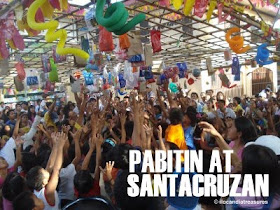 Abe V Rotor
Abe V Rotor 11. Palo de sebo (bamboo pole climbing). It is tricky – how can you climb a bamboo pole twenty feet tall covered with animal fat or vegetable oil? In childhood, because there was no rule to prevent a participant to devise his own technique, we would coach our contestant to pocket wood ash and applies it as he inched upward until he reaches the top and gets his prize.
12. Pabitin It is a portable trellis around two square meters tied at the corners to a common string, and is laden with many goodies. The setup is usually attached to the ceiling or a tree branch with a pulley of sort, enabling the game master to pull it up and down. The game is actually for children of the same age and ideally of the same height. The rule of the game is that the one who reaches and grabs the item is his. And he is supposed to leave and give chance to the other participants. It not unusual for a parent to carry a young contestant to reach for the pabitin - followed by elder children. And if the moderator is not strict, expect something unruly to happen. The game ends up into a free-for-all, and what remains of the pabitin is but a skeleton of bamboo sticks and crepe paper.
For fiestas and local parties the pabitin is popular even to this day. It is characteristically Filipino. And why not? Imagine how attractive it is up there hanging even before the start of the party. Every one would be eying what items to get. It’s apple to the eye – and remains so until the game leader declares the start of the game. The string moves and the pabitin slowly goes down, down and lands on a pack of participants shrieking, jumping, their arms instantly doubling in length.
13. Tug-of-war. It may be a parlor game, but wait until the big boys get hold of the rope. Better an outdoor game then, and be sure the rope is strong. It is a game of strength, but one in unison, so that it needs cooperation and skill. Here are some hints to win the game.
Choose the members of the team for strength and stamina. Distribute the members of the team evenly; the right handed and left handed in their proper positions on either side of the rope they feel most efficient. Keep distance to maximize individual strength with the strongest ones up front and at the rear as anchor. Distribute resistance with both feet solidly anchored on the ground. Do not allow the rope to sway; keep it steady. Anticipate surge and counteract spontaneously. Be sure you hands are protected, say with gloves or hand towel. Be wary of sudden release by your opponents, you’ll end up into a pile.
14. Jack-n-poi – It is an old game, possibly originated from China, which is used to resolve conflicts like head or tail. It is quite an intellectual and witty way. Here two or more persons play the game. Stone (clenched fist) defeats scissor (forefinger and middle finger open) but it loses to paper (palm open). Paper on the other hand submits to scissor. By law of elimination, the one who survives wins – or faces the consequence he may not like. We, kids on the farm, resolved work like taking the goat to graze, or cleaning the pig sty – and such chores we would prefer someone doing it for us.
15. Puto seko eating - Have you tried eating the powdery stuff without water, then whistle to signal you have won? It is a unique game and if you are not careful enough you will surely choke, so that it is discouraged among the very young and the sickly. Puto seko is made of rice flour, molded and dried. The contestants line the stage and on signal start eat a prescribed number of pieces. The first to finish all and produce a clear whistle wins.
Other games and sports
16. Hand cannon (palsuot)
17. Slingshot (Tirador) -
18. Foot race (different categories)
19. Bao (coconut shell) race
20. Blowgun
21. Stilt race
22. Sipa
23. Patintero
24. Hide-and-seek
25. Agawang buko (local rugby with green coconut)
There are many other native games and sports. I invite you to add to this list the native games you know, more so with those you play, or had played in your childhood. ~

I remember when I was child, me and my friends used to play tumbang preso under the moonlight. Tumbang preso is a Filipino multi-player game that uses a tin can. The it must secure the can, while his opponents try to put it down by throwing their own slippers to it.
ReplyDeletei rememebered when i was a child we usually played touching,, we used a laruan o tao tauhan as panaya,, other binabalot ng alambre na made sa tanso o nilalagyan turnilyo yung pamato para madulas at magalin makata.. the game is usually meron kayung firsan kung may linya at magpapalapitan kayo kung sinung malapit sia unang titira sa nakatayang laruan n nsa loob ng nakaguhit na square sa kalsada using chalk o uling o bato..
ReplyDelete